| کد مقاله | کد نشریه | سال انتشار | مقاله انگلیسی | نسخه تمام متن |
|---|---|---|---|---|
| 2689060 | 1143180 | 2015 | 6 صفحه PDF | دانلود رایگان |
SummaryBackground & aimsIron deficiency is the most prevalent nutritional deficiency in the United States affecting 9–16% of female adolescents. With the primary purpose of detecting iron deficiency, primary care screening consists of a hemoglobin or hematocrit laboratory test. This method is simple and inexpensive, but tests for anemia, and is neither sensitive nor specific for iron deficiency. Alternate methods for diagnosing iron deficiency using the ferritin and body iron models are not widely utilized. The study objective was to compare iron deficiency risk factors among adolescent females defined by the ferritin and body iron models to better characterize those who may benefit from iron deficiency testing as opposed to the current anemia-based screen.MethodsThis cross-sectional study of female adolescents aged 12–21 years utilized National Health and Nutrition Examination Survey 2003–2006 data. Anemia was defined by standard hemoglobin cutoffs. The ferritin model defines iron deficiency through transferrin saturation, ferritin and erythrocyte protoporphyrin laboratory testing. Body iron calculates iron status with a formula involving transferrin receptor and ferritin. Bivariate and multivariable analyses examined associations between questionnaire responses and iron deficiency defined by each model.ResultsAmong 1765 participants, 2.7% were anemic. Iron deficiency prevalence was 13.1% and 9.1% by the ferritin and body iron models, respectively. Based on the model, anemia-based screening had a sensitivity of 15.6–18.8% for iron deficiency. Multivariable associations for ferritin model iron deficiency included age, race/ethnicity, activity level and medroxyprogresterone acetate injection. Age and food insecurity were significant using the body iron model.ConclusionsUniversal anemia-based screening misses the majority of iron-deficient adolescent females. The common risk factor identified here, adolescent age, may both inform preventive care guidelines on age-based screenings and prospective studies of adolescent iron deficiency risk factors.
Journal: Clinical Nutrition ESPEN - Volume 10, Issue 3, June 2015, Pages e118–e123
